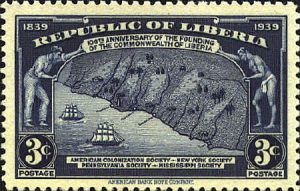The Commonwealth of Liberia
As the ACS and the settlers extended their control over tribal land – often at gunpoint – it was only the timely intervention of American, British, and other naval forces that prevented the colonists from being thrown back into the sea.
-J. Gus Liebenow
Since their arrival, through various flawed treaties, the settlers obtained more tribal land and control over native areas. The natives lost their lands not realizing sale was a final transfer to the settlers and not for life-time lease or communal usage as was the norm. This caused constant hostilities between the two groups. Even worse, the settlers also made some natives to work on their farms and in their homes and they also enforced their American way of life in the areas under their control.
With the colonists acquiring more land and establishing various settlements, the Society and state auxiliaries decided to combine the settlements to form the Commonwealth of Liberia. This conglomeration included the colonies at Cape Mesurado, the settlements of New Georgia, Caldwell and Millsburg becoming Montserrado County; and the settlements at Bexley, Buchanan and Edina becoming Grand Bassa County. The colonies at Maryland and Sinoe (Mississippi) did not join the commonwealth.
Simeon Greenleaf, a Harvard College professor, drafted the Constitution for the the Commonwealth. It was adopted on January 5th, 1839. The commonwealth would be headed by a governor and vice governor. The constitution also created a legislature that included administrators and delegates from the 2 counties. It instituted a judicial branch comprising a Supreme Court and other lesser courts.
Thomas Buchanan, Governor of Bassa and cousin of US President James Buchanan, became the first Governor of the Commonwealth. Joseph Jenkins Roberts was his Vice Governor. Buchanan took over from Anthony D. Williams who had been in charge of the colony at Monrovia and John Matthias replaced Buchanan as the Governor of Bassa.
During this time Governor Buchanan intervened  in the war between the Golas and Deys which affected the Liberian settlements along the St. Paul River. Under Robert’s leadership, the Liberian military defeated Gola Chief Gatumba and his men. Buchanan then began fostering treaties with the other chiefs.
in the war between the Golas and Deys which affected the Liberian settlements along the St. Paul River. Under Robert’s leadership, the Liberian military defeated Gola Chief Gatumba and his men. Buchanan then began fostering treaties with the other chiefs.
This era also saw a crackdown on the Atlantic slave trade by the US and British navies. The slaves from the Congo and other African regions were rescued from the slave vessels and brought to Liberia and Sierra Leone.
Buchanan then turned his attention to reorganizing the government for more efficiency. More schools were built and some natives were being converted to Christianity. The commonwealth’s exports were about $250,000 and imports estimated at $150,000. The area occupied by the settlers also increased along with their population which was estimated at 2000 freed slaves and 28,000 recaptured slaves.
By 1840, Governor Buchanan began his mission to train the settlers in self-reliance. He visited several of the settlements, began building roads in Monrovia and encouraged the residents to improve their homes. Ill and tired, he refused to return to the US, but decided to stay and complete his work in Liberia.
Thomas Buchanan died of a relapse from a fever on September 3, 1841 at Governor House, Bassa Cove, and was buried in Liberia. He was the last white leader of Liberia and known by many colonists and natives. The late governor was succeeded by Vice Colonial Governor J.J. Roberts and this marked the transition of total authority to the colonists.

Source: Pinterest
Roberts was faced with the French making their presence on the West African Coast. He worked on acquiring more land for the Commonwealth, signing treaties with various native kings and chiefs. By 1842, he planned to develop the commonwealth as an agricultural society with more schools including native pupils and increase in trade and missionary work. The most pressing issue was collecting duties/taxes.
The Mississippi State Colonization Society and the ACS agreed on a plan for the colony of Mississippi to join the Commonwealth of Liberia. This was finalized in 1842 and Mississippi in Africa became Sinoe County, the third county of the Commonwealth of Liberia.
Sources
Cassell, Abayomi C. Liberia: History of the First African Republic. Fountainhead Publishers, Inc. New York. 1970.
Liebenow, J. Liberia : the Quest for Democracy. Bloomington: Indiana University Press, 1987. Print.
Richardson, Nathaniel R. Liberia’s Past and Present. Diplomatic Press and Pub. Co., 1959. Print.
Walker, Thomas H.B. History of Liberia. Cornhill Publishing Company, Boston. 1921. Print.
Wilkeson, Samuel. A Concise History of the Commencement, Progress and Present Condition of the American Colonies in Liberia. Madisonian Office, Washington. 1839.
Views: 5482